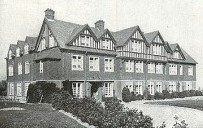9 February 1916
Bombed: Kent
At 3.26pm on a bitterly cold Wednesday afternoon, the North Goodwin Light Vessel, off the Kent coast, reported the sound of approaching aircraft. Ten minutes later observers at the North Foreland lookout post saw two German seaplanes overhead. The aircraft, a Hansa-Brandenburg NW, no. 487, flown by Leutnant Friedrich Christiansen, and a Friedrichshafen, FF33e were both from Seeflieger Abteilug (SFA) 1 based at Zeebrugge. Between them the two aircraft dropped four bombs near Ramsgate and, according to the official report, nine on Broadstairs although other accounts give 12.
Of the Broadstairs bombs, four dropped on the Bartrum Gables girls’ school in Dumpton Park Drive. One of these bombs exploded on the upper floor causing the ceiling below to fall on a class of children. One, 9-year-old Hermione Michaels, sustained slight cuts while a housemaid, Alice Earlop, was also injured. Three more bombs landed in the school grounds and although a number of the pupils were using the playing fields, damage was restricted to broken windows.
A bomb that exploded at a house named Tenerife in Dumpton Park Drive cut the cheek of a Miss Strevens and others exploded at the rear of Beresford House on Ramsgate Road and in the garden at Beaumont House.
The other four bombs were dropped to the north of Ramsgate. One, apparently aimed at a tram travelling on the main road between Broadstairs and Ramsgate, exploded in the road close behind the tram. The driver pulled up and the passengers got off, watching the aircraft as three more bombs dropped harmlessly in fields nearby, close to the Montefiore College, a synagogue and the Lillian Road School.
An eye-witness in Ramsgate reported that, ‘The raiding machines were seen by everybody in the town, and the crosses on the planes could be clearly distinguished.’
The RNAS sent up 19 aircraft in response to the attack as well as four from Dunkirk, and the RFC added five aircraft from Dover, but none was able to engage as the raiders turned for home as soon as they offloaded their bombs.
Bartrum Gables School
Casualties: 0 killed, 3 injured
Damage: £305
20 February 1916
Bombed: Suffolk & Kent
Seaplanes of SFA 1 were in action over English coastal towns again on Sunday 20 February 1916. The wireless station at Caister on the Norfolk coast picked up radio transmissions at 10.30am but before their significance could be established, bombs began falling on Lowestoft. The approaching aircraft were a Friedrichshafen FF 33e and a Hansa-Brandenburg NW. The first aircraft appeared at 10.55am and circled over the southern side of the town for about five minutes, dropping bombs and heading back out to sea. The second raider appeared at 11.10am with one report stating it remained over the town for six minutes while another claimed eiight minutes.
The raiders dropped 19 small high-explosive bombs of which one failed to detonate and two fell in the sea. The bombs caused no serious damage according to official reports, but a newspaper mentioned considerable damage to ‘two dwellings and the outbuildings of a restaurant’. One bomb exploded close to the Primitive Methodist Chapel, blowing out the windows while the congregation were inside. A newspaper reported, ‘The congregation was greatly alarmed, but left without disorder or panic, the service being abandoned.’ Three bombs also fell ‘harmlessly’ close to the gasworks. The bomb that failed to detonate crashed through the roof of a workman’s cottage and landed in the bedroom, the occupants having a lucky escape. Some slight military damage occurred at the headquarters of the 5th Provisional Brigade. A bomb struck a greenhouse and broke the telephone line; a staff captain and a clerk received minor glass cuts.
Five RNAS aircraft took off from Yarmouth to oppose the raid but with the first only getting airborne at 11.05am they were too late to engage the two raiders. A 6-pdr and a 12-pdr gun opened fired from Lowestoft, as did HMS Halcyon from the harbour, firing a single round from a 4.7-inch gun, all without effect.
Another Friedrichshafen FF 33e had already aimed bombs at shipping about five miles south of the Kentish Knock light vessel, damaging the steamer Glenfoyle, when it appeared over Walmer at around 11.20am.
According to a newspaper report many of the citizens of Walmer were out enjoying a Sunday stroll when the aircraft appeared. A cry of ‘Look out; It’s a German! Get under cover!’ was heard, then six HE bombs were released, aimed at the Royal Marine Barracks. Three of the bombs missed, falling in the sea, but one struck the target. A Marine, who was outside the barracks at the time, received slight cuts to his leg from glass splinters. Another bomb exploded in Dover Road breaking numerous windows but the remaining bomb had tragic results. Two friends, George Castle and Cecil Pedler, were walking along a road by the sea known as The Beach when the first bombs landed in the sea. Moments later another ‘fell with a blinding flash at their feet’, killing Castle, 16, and injuring Pedler, aged 17.
A large number of aircraft took off from Dover, Eastchurch and Grain but most only managed to get airborne after the raider had turned for home.
Casualties: 1 killed, 2 injured
Damage: £1,168
